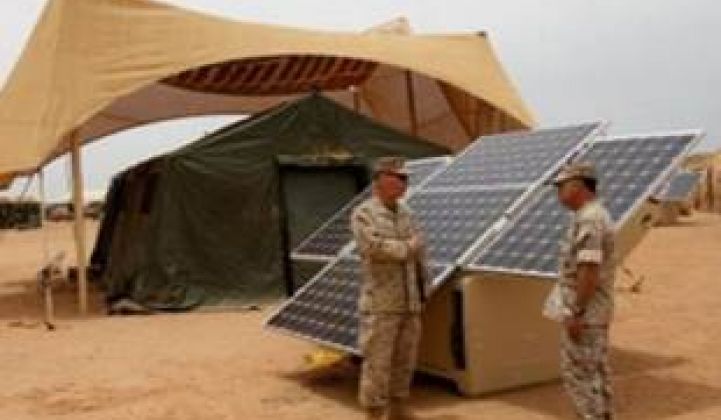With $7 billion on the table, the Army has been procuring a lot of renewable energy lately.
The latest announcement comes from the Army’s Energy Initiatives Task Force and the US Army Corps of Engineers, which jointly selected thirteen biomass vendors to compete for future orders. This is the fourth selection of vendors in recent months from the geothermal, solar, and wind industry, and is an important policy implementation step for the Department of Defense’s (DOD) path to energy security.
Collectively, these vendors were not awarded specific task orders, but instead were selected to compete with each other for individual orders in the future. When those orders roll out, the vendors will pursue a slice of the $7 billion the Army plans to spend over the next three decades. As noted in recent Army announcements, the renewable energy generation systems will be “designed, financed, constructed, operated and maintained by contractors using private sector financing.” In its current purchasing framework, the Army will buy renewable energy through power purchase agreements (PPA), and private industry will bear all of the upfront capital costs.
The initial RFP that resulted in the most recent announcement uses a Multiple Award Task Order Contract, or MATOC. The use of the MATOC, one tool in the federal contracting toolshed, is intended to streamline the contractor selection process in the hopes of awarding contracts at individual installations more quickly.
It also means that the Army’s enterprise-wide market adoption of renewable energy is ahead of a parallel DOD track addressing microgrids, which has several projects in the demonstration phase. However, “installation energy security” has not yet been defined by the DOD in terms of technical requirements or standards for microgrids, and it raises questions about whether the department is optimizing what it really wants. Without a technical requirement in place, it is difficult to assess how much installation energy security the Army is likely to buy with its plan for renewable energy procurement.
With this in mind, an October 2012 report by Business Executives for National Security (BENS) recommended that DOD establish specific energy security requirements for its installations, which would help integrate renewables procurement into microgrids. The report also advocated for microgrids to have specific characteristics, including the following:
-- Be “islandable”
-- Have the ability to integrate renewable energy
-- Be black-start-capable
-- Be sustainable for periods of weeks and months
-- Be cyber-secure
Of course, just having a microgrid does not necessarily equal installation energy security. The BENS report noted that the most “effective existing energy security solution observed” was a natural gas peaker plant located on Robins Air Force Base in Georgia. However, many of the characteristics put forward by the BENS report indicate the need to move from a general installation of renewables to specific and definable mission assurance requirements. These requirements then enter the acquisition process within each service, which then issue RFPs and task orders to private industry.
Installation energy security and associated renewable energy purchasing is made more difficult as military installations are uniquely situated with their own portfolio of power generation sources, land management and natural resource profile, and end-use demand profile. Furthermore, each installation also has its own local utility relationship and the embedded state energy policies and regulations that affect the installation-local utility relationship and the economics of potential third-party renewable energy projects.
The use of a diverse mix of renewable energy generation on an installation and distributed siting will require nuanced and particular requirements built into the task orders. This also highlights the difference between integrating a single utility-scale, renewable energy generation source onto one site on an installation, and the ability to integrate multiple types of renewable energy into several distributed sites on an installation.
Like their centralized fossil fuel step-cousins, renewable energy systems can have an infrastructure lock-in component, in some cases twenty-five years. Siting and purchasing renewable energy with clear DOD installation energy security standards in place avoids sub-optimal placement and siting of renewable energy systems.
The recent move by the military to select more renewable energy developers is an important step forward towards installation energy security. But it is only one piece of a broader strategy of clean energy deployment.
***
Michael Baskin served as a U.S. Army infantry officer from 2002-2008 with 27 months of service in Afghanistan and Iraq. He holds a BS from the U.S. Military Academy at West Point, completed an MA abroad under the post 9-11 GI Bill at the Interdisciplinary Center (IDC) Herzliya, Israel, and is a Ph.D. candidate at The Fletcher School of Law and Diplomacy at Tufts University.



